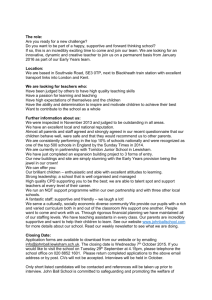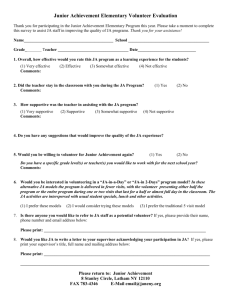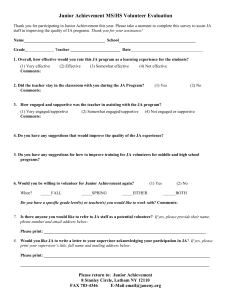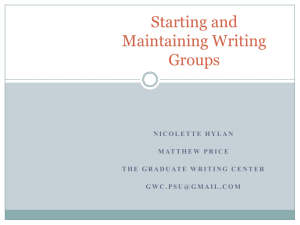Motivation Lit Review - John W. Gardner Center for Youth and Their
advertisement
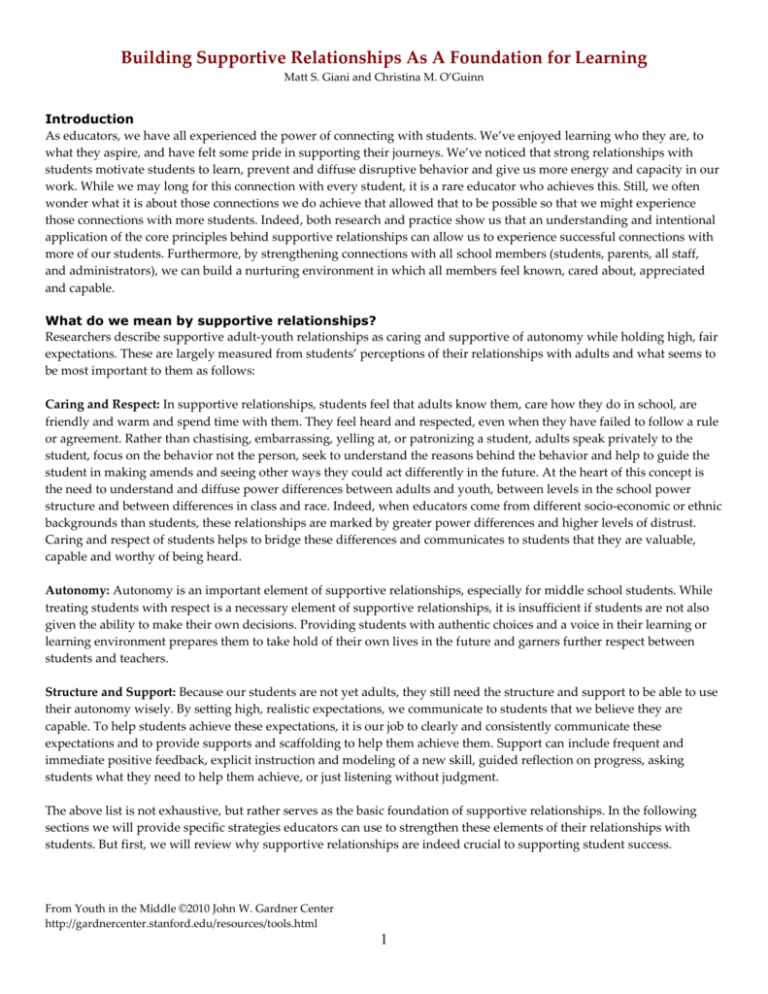
Building Supportive Relationships As A Foundation for Learning Matt S. Giani and Christina M. O’Guinn Introduction As educators, we have all experienced the power of connecting with students. We’ve enjoyed learning who they are, to what they aspire, and have felt some pride in supporting their journeys. We’ve noticed that strong relationships with students motivate students to learn, prevent and diffuse disruptive behavior and give us more energy and capacity in our work. While we may long for this connection with every student, it is a rare educator who achieves this. Still, we often wonder what it is about those connections we do achieve that allowed that to be possible so that we might experience those connections with more students. Indeed, both research and practice show us that an understanding and intentional application of the core principles behind supportive relationships can allow us to experience successful connections with more of our students. Furthermore, by strengthening connections with all school members (students, parents, all staff, and administrators), we can build a nurturing environment in which all members feel known, cared about, appreciated and capable. What do we mean by supportive relationships? Researchers describe supportive adult-youth relationships as caring and supportive of autonomy while holding high, fair expectations. These are largely measured from students’ perceptions of their relationships with adults and what seems to be most important to them as follows: Caring and Respect: In supportive relationships, students feel that adults know them, care how they do in school, are friendly and warm and spend time with them. They feel heard and respected, even when they have failed to follow a rule or agreement. Rather than chastising, embarrassing, yelling at, or patronizing a student, adults speak privately to the student, focus on the behavior not the person, seek to understand the reasons behind the behavior and help to guide the student in making amends and seeing other ways they could act differently in the future. At the heart of this concept is the need to understand and diffuse power differences between adults and youth, between levels in the school power structure and between differences in class and race. Indeed, when educators come from different socio-economic or ethnic backgrounds than students, these relationships are marked by greater power differences and higher levels of distrust. Caring and respect of students helps to bridge these differences and communicates to students that they are valuable, capable and worthy of being heard. Autonomy: Autonomy is an important element of supportive relationships, especially for middle school students. While treating students with respect is a necessary element of supportive relationships, it is insufficient if students are not also given the ability to make their own decisions. Providing students with authentic choices and a voice in their learning or learning environment prepares them to take hold of their own lives in the future and garners further respect between students and teachers. Structure and Support: Because our students are not yet adults, they still need the structure and support to be able to use their autonomy wisely. By setting high, realistic expectations, we communicate to students that we believe they are capable. To help students achieve these expectations, it is our job to clearly and consistently communicate these expectations and to provide supports and scaffolding to help them achieve them. Support can include frequent and immediate positive feedback, explicit instruction and modeling of a new skill, guided reflection on progress, asking students what they need to help them achieve, or just listening without judgment. The above list is not exhaustive, but rather serves as the basic foundation of supportive relationships. In the following sections we will provide specific strategies educators can use to strengthen these elements of their relationships with students. But first, we will review why supportive relationships are indeed crucial to supporting student success. From Youth in the Middle ©2010 John W. Gardner Center http://gardnercenter.stanford.edu/resources/tools.html 1 Why are supportive relationships important to youth outcomes? You may be asking yourself, “So what? Why are relationships important to youth and, most importantly, how do supportive relationships relate to students’ academic outcomes?” While supportive relationships are important to the development of youths’ social skills, a great deal of research has also shown that strong, supportive relationships between teachers and students have a positive effect on students’ academic outcomes such as better grades and higher graduation rates. Below is a brief review of some of the potential impacts of developing supportive relationships with your students. In a number of studies, students’ feelings of belonging and closeness with their teacher have been shown to be related to positive academic outcomes, such as working harder in school, spending more time on homework and receiving better grades (Birch & Ladd, 1997; Roeser, Midgley, & Urdan, 1996; Murray & Greenberg, 2000). Students who perceive their relationships with their teacher as close and supportive have more confidence in their academic ability, which in turn leads to more engagement with school (Roeser, Midgley, & Urdan, 1996). In addition, research has shown that studentteacher relationships can reduce behavior such as aggression and defiance of authority important to establishing a high level learning environment. In other words, when students are treated as if they are capable and competent enough to perform at a high level, they believe it, and this belief gives them the confidence and motivation to try harder and perform better (Murray & Greenberg, 2000). All of these effects of supportive relationships eventually lead to better academic outcomes. Supportive relationships can be particularly important when there is a mismatch between the social, emotional, and academic skills or cultural background that students arrive with and the expectations and culture of the school. All students require caring, support, encouragement, safety, scaffolding, and explicit instruction to learn the skills and important social norms necessary for successfully navigating structures and norms established by the majority culture. Alternatively, conflict and dependency between students and teachers have been found to lead to more negative student attitudes towards school, less academic engagement, and poorer academic outcomes for students (Birch & Ladd, 1997). Positive relationships, therefore, are a key ingredient in students’ feelings of belongingness and adjustment to school, their confidence and motivation, critical life-skill development, and their overall academic performance. What can I do to build supportive relationships with my students? While we have discussed supportive relationships in an abstract way, you may still be asking yourself precisely what you can do to build supportive relationships with your students. Know that your student relationships matter. The first step is to know and believe that your relationships matter and will make a difference. We know from research that teachers’ beliefs about their own ability to affect student outcomes are strongly correlated to student achievement (Tschannen-Moran, Hoy, & Hoy, 1998). When teachers believe that they are powerless to change their students’ beliefs, attitudes, behavior, or academic performance, they are much less likely to do so. But when teachers believe that they can have a profound effect on their students, they have a much greater likelihood of making a positive impact on students. Researchers call these attitudes and beliefs “teacher efficacy,” or the degree to which teachers believe they can affect outcomes/impact (Tschannen-Moran, Hoy, & Hoy, 1998). When we are not experiencing a lot of success with students, our teacher efficacy declines. We recognize it in ourselves and others, when we begin to blame others: “These students are lazy. They don’t want to learn. Their parents aren’t disciplining them and don’t care about their education. The administrators aren’t doing enough to discipline students.” What we are really saying is, “I feel like I’ve done all I know how to do, and nothing works, so I feel that I cannot make a difference.” The reality for many of us is that the methods we used that were/are effective with some students don’t necessarily work with all students, and so we have to be willing to try different strategies until we find ones that will work with all students. This can take a lot of creativity and courage, but when teachers begin to ask themselves, “What From Youth in the Middle ©2010 John W. Gardner Center http://gardnercenter.stanford.edu/resources/tools.html 2 can I do to reach every student?” and begin to seek and try new ideas of strategies from others, they are on the path to increasing their efficacy and, in turn, student achievement. Believe in your students. Just as your belief in your own ability to impact students is critical to your success, so is their belief in themselves, which you can influence. Self-fulfilling prophecy is very powerful. We recognize it when we hear a student say, “What’s the point in trying. I’m just going to drop out anyway.” If a student truly believes s/he can be successful, s/he tends to be highly motivated to learn. We have tremendous influence on these beliefs, for students can sense what we believe about them by the things we say and do. Research has extensively shown that if teachers believe that students are “low achievers,” “unmotivated”or“bad kids,” even if previously the students were well-behaved and successful students, the students will begin to exhibit more behavior problems and perform worse in school (Brophy & Good, 1974). Alternatively, students are more likely to succeed if teachers perceive of them as smart and capable, even if they struggled in school previously (Ibid). Make your belief in and care for students intentional and transparent. Believing is just the beginning. We also have to communicate this belief to our students through our words and deeds, letting them know that we believe in them, care about them and know they can succeed. In other words, even if we believe that we truly care for students, our beliefs will be ineffective if students do not perceive that we care for them (Wentzel, 1997). The only way to know if young people perceive us as caring is to ask them. This could occur through surveys, one-on-one or in a focus group in which adults can ask students if they feel adults in the school care about them, how they know an adult cares, or what adults can do to help students feel cared for. Below are some examples of actions that researchers and practitioners have found helpful in building supportive relationships with students. Smile to set the tone: This may seem self-evident, but a smile can be a powerful signal of your mood and attitude towards your students. Non-verbal signals, like smiling, have even been found to be more influential in positively changing student behavior than words alone (Kazdin & Klock, 1973). Even when you don’t feel like smiling, a smile can set the tone and shift your own mood. Make caring eye contact1: When students are misbehaving or off-task, teachers often slip into the dreaded “teacherstare” in an attempt to scare the student straight. While your eyes can communicate your disapproval, they can also communicate your care and concern. Try and make caring eye contact with all your students, but especially those you suspect to be struggling. Stay calm: To be sure, this is often not an easy task. If our students are being disruptive or disobedient, aren’t performing as well as we know they can, or if we are just having a bad day, it is easy for us to lose our composure in the classroom. But even when students require discipline, doing so in a calm and tempered manner, while still being stern and forceful, shows students that we respect them even if we disapprove of their behavior. Listen and show youth they’ve been heard: Youth at this age often don’t feel that they are heard or appreciated causing them to feel disconnected and disengaged with school. Ask students questions, not just about class material but about their opinions on life and things that they see around them. Show students that you’ve listened to them by restating their ideas and explicitly connecting their interests and input to instruction or to decisions made that they informed. Students feel empowered when they are taken seriously as knowledgeable and valuable participants in conversation (Hudson-Ross, Cleary & Casey, 1993), which motivates them to take ownership of their educational experience (Colsant, 1995; Sanon, Baxter, Fortune & Opotow, 2001). 1 Eye contact should be used only when culturally appropriate. In some cultures, eye contact is considered disrespectful. From Youth in the Middle ©2010 John W. Gardner Center http://gardnercenter.stanford.edu/resources/tools.html 3 Notice their strengths and provide encouragement: Of course, school is not easy for all students and many of them will struggle from time to time and will need encouragement to persist through challenges. Keep your expectations for these students high, and remember to tell them that you know they can succeed if they continue to work hard. Look for and recognize their efforts, their progress and their positive behaviors. Provide support: If students continue to struggle behaviorally or academically, work with them individually, help them to set personal near-term goals and check in on their progress regularly. This will show the student that you are invested in and care about their success, and will also allow you to build personal relationships with your students. While the above practices have been found to be successful in research studies, there is also anecdotal evidence from practitioners and what we hear from students themselves that certain actions help educators connect with students. Below are some examples. Use humor: This is an age where kids are very social and develop a strong sense of humor. They are often laughing at everything. Rather than get angry at students’ goofiness, adults can laugh with youth as appropriate and build humor into instruction. However, certain forms of humor widely used among youth, such as insults and sarcasm, can be damaging to youth. Sarcasm, in particular, can lead to many misunderstandings, as some cultures do not have sarcasm, so students take comments literally and can feel insulted. Adults need to model and enforce appropriate humor particularly and avoid humor performed at the expense of other individuals or groups. Share your own stories: Youth are interested in you and who you are as a person other than a teacher or principal or staff member. They tend to share more of themselves when you do too, and they consistently tell us that they enjoy seeing you outside your normal role—having fun or sharing your passions. You are a role model, and they are watching you very closely, even though it may not seem like it. This is particularly important for students from different backgrounds than yourself—as things you reveal about yourself may help them to see similarities with you, and if you share your weaknesses/struggles, it will help them to realize that they can also overcome their own challenges. Let your students know what school was like for you, what you learned from your education and share other personal narratives that might be of interest to your students. It is also important to introduce students to role models of similar background to their own who have overcome significant challenges. Listen and adjust: Young people communicate very clearly what’s going on with them. It’s just not always done in a way adults might perceive as polite and doesn’t always fit with our plan for the day, so we tend to ignore their feedback. To the degree we can listen and respond, we will better meet the needs of young people, form stronger connections with youth and experience more success and joy in our work with students. Youth often say what they are thinking (e.g. “This is boring,” “I’m hungry,” “I don’t understand why we have to learn this.”) They also show us what they are thinking with their body language or actions (e.g, squirming in their chair indicating that they have been sitting too long and need to move around, socializing with a neighbor or talking out in class indicating that they may need to process what they are learning through talking, not working or paying attention indicating they are not engaged or don’t understand.) Oftentimes, when students act out and criticize the lesson or us, they are really telling us that they are frustrated or are unsure they can be successful. It’s critical that we don’t take their comments personally, but rather try to get at what is behind the message and help them to be more aware of what they are really feeling. While it can be hard to respond to all these signals all the time, even quietly acknowledging to individuals that you notice they are struggling and you appreciate them hanging in with you can help, particularly if you show you are responsive other times. Some ways that you might adjust to these signals might include: Building in physical movement: Middle school youth are growing, and they need to be active. It is hard to sit all day, so even just having stretch breaks or activities that allow them to move around can help channel this energy and prevent frustration. From Youth in the Middle ©2010 John W. Gardner Center http://gardnercenter.stanford.edu/resources/tools.html 4 Allowing for social interaction: Young adolescents are extremely social and need to talk. Research shows that conversation is an important way of processing new information, making connections and creating deeper understanding of content. This need for young people to talk can be leveraged by intentionally building in protocols such as “Think, Pair, Share,” timed conversations or collaborative learning. Practice active listening with youth: When adults show that they are listening, youth will often shift from fighting you to working with you even when you can’t grant their every wish. This is particularly effective when done one-on-one. When a youth complains, questions an activity or even starts to act inappropriately, try pulling him or her aside and asking from a place of genuine care and curiosity with the intent of understanding the messages behind his or her signals and how you can help. For example: “I heard you say you were bored and I noticed you making inappropriate noises. Can you tell me what’s going on? Is this activity too easy for you? Do you need more help with it? Do you need to move around a bit? What will help you to focus?” You can show compassion and then share your perspective in the same respectful manner. “I hear you saying that you’re struggling with this skill and you don’t understand why you need to learn it. I can understand why you would be frustrated, and based on what you’ve told me, it sounds like I need to break down this skill a little more for you and explain why the skill is important. Does that sound right? Will that help?” Finally, you can help improve respectful but open communication in future and work with youth to take more responsibility for their own learning by saying something like, “Thank you for telling me what you need. This shows that you are taking responsibility for your own learning and helps me to help you. I’m always available to you at lunch if you need to come get additional help.” Ask students what helps them connect with adults: Practitioners have observed that just having a one-on-one conversation or surveying students, results in stronger relationships with students, because it communicates that you care about them and value their opinion. This is even more powerful when you show students how their input resulted in change. Adolescents who are part of an organization called What Kids Can Do (2005) have also released numerous publications to help adults better understand, listen to, and work with youth. In many ways, the words of youth are the most powerful, so we include some of their recommendations in their own words, which reiterate many of the strategies already described: “We might act like we hate you, but we care what you say and do.” (p.1) “We know what you really care about, because we watch what you say and do.” (p. 1) “If you push us too hard we might break, so give us room to figure things out.” (p. 15) “Your opinions really matter to us, but we have to decide things for ourselves.”(p. 42) “When you listen to me, show me you respect me by paying attention and not judging me.” (p.70) “We already feel bad enough about our mistakes—don’t make us feel worse.” (p.70) “If you want us to do better, praise what we do well already.” (p.70) “Respect what’s important to us, and we’ll respect what’s important to you.” (p.70) “When you tell us your problems and mistakes, it’s easier to trust you with ours.”(p. 87) “If you treat us like we’re little kids, we’ll act that way—so don’t.” (p. 104) “We’ll cooperate with you better, if you can relax a little.” (p. 104) “If we don’t agree, let’s work out a compromise.” (p. 104) “If we see that you respect us, we’ll accept your help.” (p. 104) “We need to take risks, so help us find ones that won’t hurt us.” (p. 104) “We love doing things with you that puts us on an equal footing.” (p. 139) “We want to learn your skills, and we could teach you ours.” (p. 139) “We’ll never forget the time you make to do something just with us.” (p. 139) What if my students don’t seem interested in connecting? While we have discussed some evidence showing the importance of positive student-teacher relationships and reviewed some promising practices related to building these relationships, a lingering doubt may still remain: What if my students From Youth in the Middle ©2010 John W. Gardner Center http://gardnercenter.stanford.edu/resources/tools.html 5 just aren’t interested in connecting? This concern is legitimate. Indeed, some studies have found that students begin to report stronger relationships with their peers and weaker relationships with adults during the transition to middle school (Linch & Ciccheti, 1997). Middle school students in general need more independence as they grow older and many place a higher value on peer opinions than adult opinions. Furthermore, students may have had bad experiences with past teachers, may feel unappreciated by adults, or may even be going through difficulties unrelated to your school environment that cause them to be disengaged. Additionally, we as educators must fill a difficult role in the lives of students. We are both allies and enforcers of discipline, supporters and restrictors of student behavior. Yet while middle school students are more independent than elementary students, they still need support, care, and encouragement from their teachers in order to properly adjust to their new school environment and succeed academically. It’s important to always keep the door open to all students for several reasons. First, while some students may seem unwilling to connect, most students not only desire but need supportive relationships with adults in order to succeed in school, and while they may not show it outwardly your opinion matters to them a great deal and can make a difference in how they perceive themselves during this formative time. Second, through patience, dedication, and unwavering support on the part of the teacher, even students that initially seem reluctant to open up and connect with their teachers can turn around, as many studies have shown. Third, even if students don’t openly show their appreciation or how much your opinion of them matters, they do show us that our support matters by putting more effort into their work. Finally, we sometimes gauge the strength of our relationships with students by how often students confide in us or how much of their personal lives they share with us. While this may be a sign of a strong relationship, we should also be aware that students have a need for privacy just as we do. We should strive to be open and approachable without trying to force students to share information that they may be uncomfortable with sharing. In other words, supportive relationships with each student do not all look the same; we must listen and respond to the individual needs of each student. Do adult relationships affect relationships with youth? Thus far we have only discussed student-teacher relationships as being important for youth outcomes, but adult relationships also have a strong impact on students. We often believe that what students don’t see can’t hurt them, or that our interactions with our colleagues have marginal, if any, impact on our students, but as former principal and current Harvard professor of education Roland S. Barth notes, “The success of a school…depends above all on the quality of interactions between teacher and teacher, and teacher and administrator” (Barth, 1990). Barth stresses the importance of adults modeling the types of relationships that should be established between all members of the school community. Foremost in importance among these adult relationships, he argues, is that between the principal and the teachers. “If the teacher-principal relationship can be characterized as helpful, supportive, trusting, revealing of craft knowledge, so too will others,” but if “teacher-principal interactions are suspicious, guarded, distant, adversarial, acrimonious, or judgmental, we are likely to see these traits pervade the school,” (Ibid) and the effect will even reach our students. Similarly, relational trust between all adult school members was found to be critical to school change success in Anthony Bryk and Barbara Schneider’s study of twelve Chicago elementary schools engaged in school change efforts in the late 1980s. In this study Bryk and Schneider found that high levels of relational trust between principals, teachers, parents, and community leaders was linked to demonstrated gains in student achievement, while schools with low levels of relational trust saw virtually no improvement in reading or math test scores (Bryk 2002, pp 123-4). Indeed, even in schools that lacked resources for their school improvement efforts still saw gains in student test scores if relational trust was high. Bryk and Schneider theorize that this trust is crucial, because all adult members depend on each other in order to achieve success, and the nature of school success relies heavily on cooperative efforts around local problem solving. Furthermore, trust allows school members to feel safe to take risks, share their practices, challenge each other's thinking, overcome fears of data, work through conflict, and try new approaches in their school. From Youth in the Middle ©2010 John W. Gardner Center http://gardnercenter.stanford.edu/resources/tools.html 6 Indeed, the success of school improvement efforts relies heavily upon the relationships teachers have with each other. Barth argues that “the relationships among adults in schools…allow, energize, and sustain all other attempts at school improvement” (Ibid). If we as educators reach out to each other, share our practices with one another, and offer support and guidance to collaboratively find strategies to reach all of our students, we can create the type of safe and nurturing environment needed to ensure our students’ success. Additional Resources to Support Relationship Building between Adults: The Five Dysfunctions of a Team by Patrick Lencioni What Got You Here Won't Get You There by Marshall Goldsmith and Mark Reiter Difficult Conversations by Douglas Stone et al. Fierce Conversations by Susan Scott Crucial Conversations by Kerry Patterson et al. Works Cited Barth, R. S. (1990). Improving schools from within: Teachers, parents, and principals can make the difference. San Francisco, CA: Jossey-Bass. Birch, S. H. & Ladd, G. W. (1997). The teacher-child relationship and children’s early school adjustment. Journal of School Psychology, Vol. 35(1), pp. 61-79. Brophy, J. E. & Good, T. L. (1974). Teacher-student relationships: Causes and consequences. US: Holt, Rinehart, and Winston, Inc. Bryk, S. and Schneider, B (2002). Trust in Schools: A Core Resource for Improvement. New York, NY: Russell Sage Foundation. Colsant, L. (1995). “Hey, man, why do we gotta take this . . . ?” Learning to listen to students. In J. G. Nicholls & T. A. Thorkildsen (Eds.), Reasons for learning: Expanding the conversation on student-teacher collaboration, pp. 62–89. New York: Teachers College Press. Cushman, K. & the youth of What Kids Can Do. (2005). What We Can’t Tell You: Teenagers Talk to the Adults in Their Lives. Providence, RI: Next Generation Press. Eccles, J. S., & Midgley, C. (1989). Stage/environment fit: Developmentally appropriate classrooms for early adolescents. In R. E. Ames & C. Ames (Eds.), Research on Motivation in Education, Vol. 3, pp. 139-186. New York: Academic Press. Hudson-Ross, S., Cleary, L., & Casey, M. (1993). Children’s voices: Children talk about literacy. Portsmouth, NH: Heineman. Hamre, B. K. & Pianta, R. C. (2001). Early teacher-child relationship and the trajectory of children’s school outcomes through eighth grade. Child Development, Vol. 72(2), pp. 625-638. Kazdin, A. E. & Klock, J. (1973). The effect of nonverbal teacher approval on student attentive behavior. Journal of Applied Behavioral Analysis, Vol. 6(4), pp. 643-654. From Youth in the Middle ©2010 John W. Gardner Center http://gardnercenter.stanford.edu/resources/tools.html 7 Klem, A.M. and Connell, J.P. (2004). Relationships Matter: Linking Teacher Support to Student Engagement and Achievement. Paper presented at the Tenth Biennial Meeting of the Society for Research on Adolescence, March 11-14, 2004, Baltimore, Maryland. Philadelphia: Institute for Research and Reform in Education. Lippman, L. & Rivers, A (2008). Assessing school engagement: A guide for out-of-school time program practitioners. Child Trends: Research to Results, 2008-39. Lynch, M. & Cicchetti, D. (1997). Children’s relationships with adults and peers: An examination of elementary and junior high school students. Journal of School Psychology, Vol. 35(1), pp. 81-99. Midgley, C., Feldlaufer, H. & Eccles, J. S. (1989). Student/teacher relations and attitudes towards mathematics before and after the transition to junior high school. Child Development, Vol. 60(4), pp. 981-992. Murray, C. & Greenberg, M. T. (2000). Children’s relationship with teachers and bonds with school: An investigation of patterns and correlates in middle childhood. Journal of School Psychology, Vol. 38(5), pp. 423-445. Pianta, R. (1999). Enhancing relationships between children and teachers. Washington, DC: American Psychological Association. Roeser, R. W., Midgley, C. & Urdan, T. C. (1996). Perceptions of the school psychological environment and early adolescents’ psychological and behavioral functioning in school: The mediating role of goals and belonging. Journal of Educational Psychology, Vol. 88(3) pp. 408-422. Sanon, F., Baxter, M., Fortune, L., & Opotow, S. (2001). Cutting class: Perspectives of urban high school students. In J. Shultz & A. Cook-Sather (Eds.), In our own words: Students’ perspectives on school (pp. 73–91). Lanham, MD: Rowman & Littlefield. Silver, R. B., Measelle, J. R., Armstrong, J. M., & Essex, M. J. (2005). Trajectories of classroom externalizing behavior: Contributions of child characteristics, family characteristics, and teacher-child relationship during the school transition. Journal of School Psychology, Vol. 43, pp. 49-60. Trickett, E.J. and Moos, R H. (1995). Classroom Environment Scale Manual. 3rd Edition. Palo Alto, CA: Consulting Psychologists Press. Tschannen-Moran, M. Hoy, A. W., & Hoy, W. K. (1998). Teacher efficacy: Its meaning and measure. Review of Educational Research, Vol. 68(2), pp. 202-248. Wentzel, K. R. (1997). Student motivation in middle school: The role of perceived pedagogical caring. Journal of Education Psychology, Vol. 89, No. 3, 411-419. Wentzel, K. R. (2002). Are effective teachers like good parents? Teaching styles and student adjustment in early adolescence. Child Development, Vol. 73(1), pp. 287-301. From Youth in the Middle ©2010 John W. Gardner Center http://gardnercenter.stanford.edu/resources/tools.html 8
